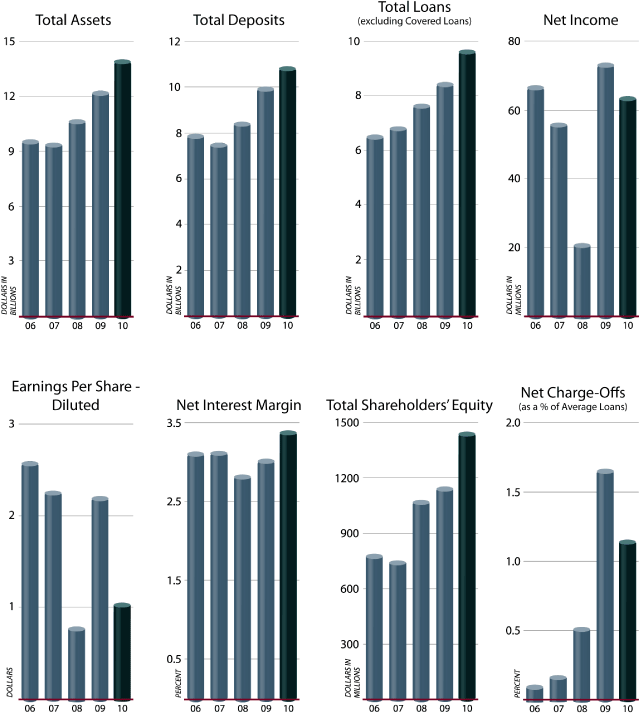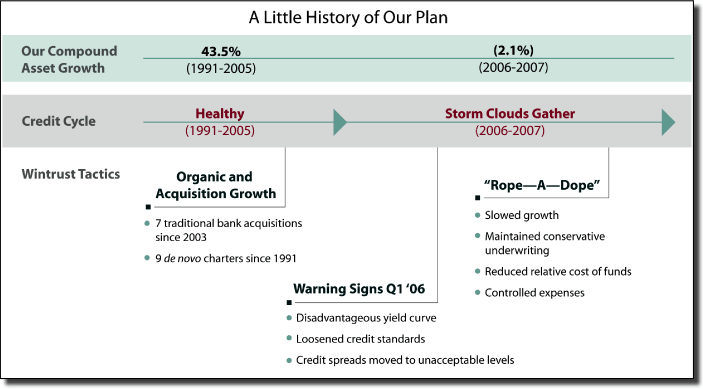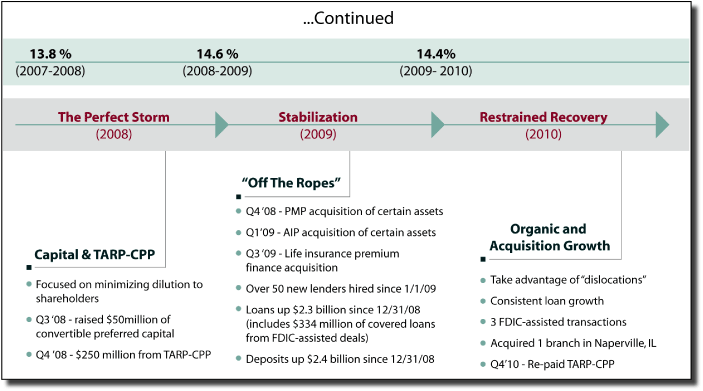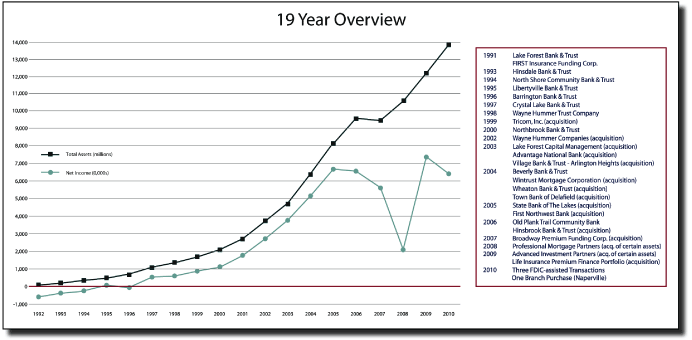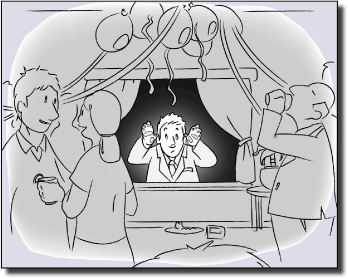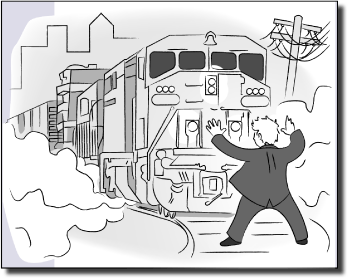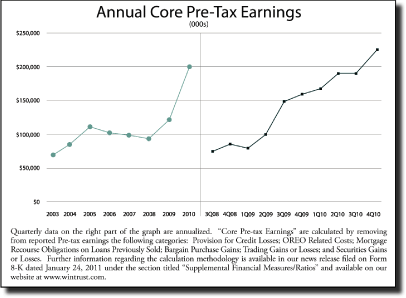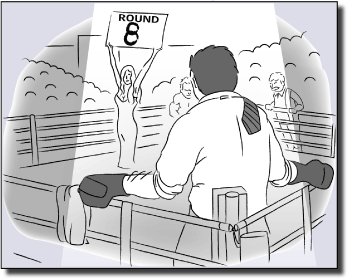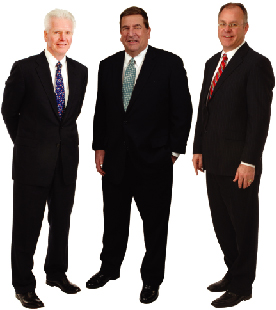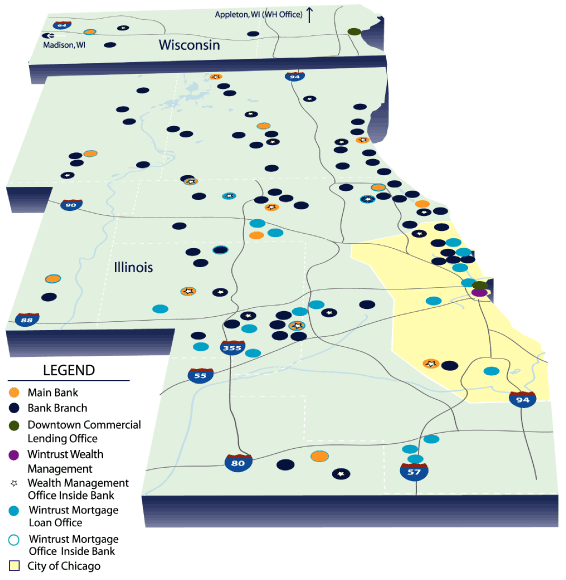Exhibit 13.1
2010—Sticking to the Plan
Wintrust allows you, your business or the company you work for to HAVE IT ALL.
At Wintrust, we offer the products and technology of the big banks but pair it with exceptional
service, understanding and proper focus. It means you can Have It AllTM — a full slate of powerful
and sophisticated financial products and the local decision making and personal service that only a
group of community banks and specialty financial companies can offer.
Retail Banking
| | • | | Footprint of 15 chartered banks and 86 facilities |
| |
| | • | | Deposit Products |
| |
| | • | | Home Equity & Installment Loans |
| |
| | • | | Residential Mortgages |
Wealth Management
| | • | | Asset Management (Individual & Institutional) |
| |
| | • | | Financial Planning |
| |
| | • | | Brokerage |
| |
| | • | | Retirement Plans (Business) |
| |
| | • | | Trust & Estate Services (Corporate & Personal) |
| |
| | • | | Life Insurance Premium Financing |
Commercial Lending
| | • | | Commercial & Industrial (Asset Based) Lending |
| |
| | • | | Commercial Real Estate, Mortgages & Construction |
| |
| | • | | Lines of Credit |
| |
| | • | | Letters of Credit |
| |
| | • | | Commercial Insurance Premium Financing |
Treasury Management
| | • | | Retail & Wholesale Lockbox |
| |
| | • | | On-Line Lockbox (iBusinessPay) |
| |
| | • | | On-Line Banking & Reporting (iBusinessBanking) |
| |
| | • | | Remote Deposit Capture (iBusinessCapture) |
| |
| | • | | Merchant Card Program |
| |
| | • | | Payroll Services (CheckMate) |
| |
| | • | | ACH & Wire Transfer Services |
| |
| | • | | International Banking Services |
Specialized Financial Services for:
| | • | | Building Management Companies |
| |
| | • | | Condominium & Homeowner Associations |
| |
| | • | | Franchisees |
| |
| | • | | Indirect Automobile Lending |
| |
| | • | | Insurance Agents & Brokers |
| |
| | • | | Mortgage Companies (Warehouse Lending) |
| |
| | • | | Municipalities & School Districts |
| |
| | • | | Physicians, Dentists & Other Medical Personnel |
| |
| | • | | Temporary Staffing & Security Companies |
Selected Financial Trends
| | |
| | | |
| |
| | | |
| 2 | | Wintrust Financial Corporation |
Selected Financial Highlights
| | | | | | | | | | | | | | | | | | | | | |
| | | Years Ended December 31, |
| | | 2010 | | 2009 | | 2008 | | 2007 | | 2006 |
| | | (dollars in thousands, except per share data) |
Selected Financial Condition Data
(at end of year): | | | | | | | | | | | | | | | | | | | | |
| Total assets | | $ | 13,980,156 | | | $ | 12,215,620 | | | $ | 10,658,326 | | | $ | 9,368,859 | | | $ | 9,571,852 | |
| Total loans, excluding covered loans | | | 9,599,886 | | | | 8,411,771 | | | | 7,621,069 | | | | 6,801,602 | | | | 6,496,480 | |
| Total deposits | | | 10,803,673 | | | | 9,917,074 | | | | 8,376,750 | | | | 7,471,441 | | | | 7,869,240 | |
| Junior subordinated debentures | | | 249,493 | | | | 249,493 | | | | 249,515 | | | | 249,662 | | | | 249,828 | |
| Total shareholders’ equity | | | 1,436,549 | | | | 1,138,639 | | | | 1,066,572 | | | | 739,555 | | | | 773,346 | |
| | | | | | | | | | | | | | | | | | | | | |
| |
Selected Statements of Income Data: | | | | | | | | | | | | | | | | | | | | |
| Net interest income | | $ | 415,836 | | | $ | 311,876 | | | $ | 244,567 | | | $ | 261,550 | | | $ | 248,886 | |
Net revenue(1) | | | 607,996 | | | | 629,523 | | | | 344,245 | | | | 341,493 | | | | 339,926 | |
Core pre-tax earnings(2) | | | 196,544 | | | | 122,803 | | | | 94,410 | | | | 95,552 | | | | 102,566 | |
| Net income | | | 63,329 | | | | 73,069 | | | | 20,488 | | | | 55,653 | | | | 66,493 | |
| Net income per common share — Basic | | | 1.08 | | | | 2.23 | | | | 0.78 | | | | 2.31 | | | | 2.66 | |
| Net income per common share — Diluted | | | 1.02 | | | | 2.18 | | | | 0.76 | | | | 2.24 | | | | 2.56 | |
| | | | | | | | | | | | | | | | | | | | | |
| |
Selected Financial Ratios and Other Data: | | | | | | | | | | | | | | | | | | | | |
Performance Ratios: | | | | | | | | | | | | | | | | | | | | |
Net interest margin(2) | | | 3.37 | % | | | 3.01 | % | | | 2.81 | % | | | 3.11 | % | | | 3.10 | % |
| Non-interest income to average assets | | | 1.42 | | | | 2.78 | | | | 1.02 | | | | 0.85 | | | | 1.02 | |
| Non-interest expense to average assets | | | 2.82 | | | | 3.01 | | | | 2.63 | | | | 2.57 | | | | 2.56 | |
Net overhead ratio(3) | | | 1.40 | | | | 0.23 | | | | 1.60 | | | | 1.72 | | | | 1.54 | |
Efficiency ratio(2)(4) | | | 63.77 | | | | 54.44 | | | | 73.00 | | | | 71.05 | | | | 66.94 | |
| Return on average assets | | | 0.47 | | | | 0.64 | | | | 0.21 | | | | 0.59 | | | | 0.74 | |
| Return on average common equity | | | 3.01 | | | | 6.70 | | | | 2.44 | | | | 7.64 | | | | 9.47 | |
| | | | | | | | | | | | | | | | | | | | | |
| Average total assets | | $ | 13,556,612 | | | $ | 11,415,322 | | | $ | 9,753,220 | | | $ | 9,442,277 | | | $ | 8,925,557 | |
| Average total shareholders’ equity | | | 1,352,135 | | | | 1,081,792 | | | | 779,437 | | | | 727,972 | | | | 701,794 | |
| Average loans to average deposits ratio (excluding covered loans) | | | 91.1 | % | | | 90.5 | % | | | 94.3 | % | | | 90.1 | % | | | 82.2 | % |
| Average loans to average deposits ratio (including covered loans) | | | 93.4 | % | | | 90.5 | % | | | 94.3 | % | | | 90.1 | % | | | 82.2 | % |
| | | | | | | | | | | | | | | | | | | | | |
Common Share Data (at end of year): | | | | | | | | | | | | | | | | | | | | |
| Market price per common share | | $ | 33.03 | | | $ | 30.79 | | | $ | 20.57 | | | $ | 33.13 | | | $ | 48.02 | |
Book value per common share(2) | | $ | 32.73 | | | $ | 35.27 | | | $ | 33.03 | | | $ | 31.56 | | | $ | 30.38 | |
Tangible common book value per share(2) | | $ | 25.80 | | | $ | 23.22 | | | $ | 20.78 | | | $ | 19.02 | | | $ | 18.97 | |
| Common shares outstanding | | | 34,864,068 | | | | 24,206,819 | | | | 23,756,674 | | | | 23,430,490 | | | | 25,457,935 | |
| | | | | | | | | | | | | | | | | | | | | |
Other Data (at end of year):(8) | | | | | | | | | | | | | | | | | | | | |
| Leverage ratio | | | 10.1 | % | | | 9.3 | % | | | 10.6 | % | | | 7.7 | % | | | 8.2 | % |
| Tier 1 capital to risk-weighted assets | | | 12.5 | | | | 11.0 | | | | 11.6 | | | | 8.7 | | | | 9.8 | |
| Total capital to risk-weighted assets | | | 13.8 | | | | 12.4 | | | | 13.1 | | | | 10.2 | | | | 11.3 | |
Tangible common equity ratio (TCE)(2)(7) | | | 8.0 | | | | 4.7 | | | | 4.8 | | | | 4.9 | | | | 5.2 | |
Allowance for credit losses(5) | | $ | 118,037 | | | $ | 101,831 | | | $ | 71,353 | | | $ | 50,882 | | | $ | 46,512 | |
Credit discounts on purchased premium finance receivables — life insurance(6) | | | 23,227 | | | | 37,323 | | | | — | | | | — | | | | — | |
| Non-performing loans | | | 142,132 | | | | 131,804 | | | | 136,094 | | | | 71,854 | | | | 36,874 | |
Allowance for credit losses to total loans(5) | | | 1.23 | % | | | 1.21 | % | | | 0.94 | % | | | 0.75 | % | | | 0.72 | % |
| Non-performing loans to total loans | | | 1.48 | | | | 1.57 | | | | 1.79 | | | | 1.06 | | | | 0.57 | |
| | | | | | | | | | | | | | | | | | | | | |
| Number of: | | | | | | | | | | | | | | | | | | | | |
| Bank subsidiaries | | | 15 | | | | 15 | | | | 15 | | | | 15 | | | | 15 | |
| Non-bank subsidiaries | | | 8 | | | | 8 | | | | 7 | | | | 8 | | | | 8 | |
| Banking offices | | | 86 | | | | 78 | | | | 79 | | | | 77 | | | | 73 | |
| |
| | |
| (1) | | Net revenue is net interest income plus non-interest income. |
| |
| (2) | | See Item 7, “Management’s Discussion and Analysis of Financial Condition and Results of Operations — Non-GAAP Financial Measures/Ratios,” of the Company’s 2010 Form 10-K for a reconciliation of this performance measure/ratio to GAAP. |
| |
| (3) | | The net overhead ratio is calculated by netting total non-interest expense and total non-interest income and dividing by that period’s average total assets. A lower ratio indicates a higher degree of efficiency. |
| |
| (4) | | The efficiency ratio is calculated by dividing total non-interest expense by tax-equivalent net revenues (less securities gains or losses). A lower ratio indicates more efficient revenue generation. |
| |
| (5) | | The allowance for credit losses includes both the allowance for loan losses and the allowance for unfunded lending-related commitments. |
| |
| (6) | | Represents the credit discounts on purchased life insurance premium finance loans. |
| |
| (7) | | Total shareholders’ equity minus preferred stock and total intangible assets divided by total assets minus total intangible assets |
| |
| (8) | | Asset quality ratios exclude covered loans. |
To Our Fellow Shareholders
Welcome to Wintrust Financial Corporation’s 2010 annual report. We thank you for being a shareholder.
First, let’s set the stage.
We are over a year into a recovery that appears to be neither robust nor confidence inspiring. Consider that 2010 ended with-
| | • | | A national unemployment rate of 9.4%, with the rate for Illinois and Chicago area at 9.3%. While an improvement over 2009, we still have nearly 400,000 friends, neighbors, and customers out of work. |
| |
| | • | | The FDIC closing 157 banks nationwide. Eighteen of those banks were in Illinois and Wisconsin. |
| |
| | • | | A housing market still in decline. Chicago area home values dropped another 7% in 2010, with a more than 25% drop in the last three years. |
| |
| | • | | The Chicago area placing second in the nation (behind Phoenix) in home repossessions. More than 45,000 homes were repossessed in the Chicago area in 2010, with the area seeing nearly 139,000 foreclosure notices. |
| |
| | • | | One out of every 27 Chicago area properties receiving a foreclosure notice in 2010. The national average for 2010 was one out of every 45. |
| |
| | • | | According to Moody’s, the state of Illinois and the Chicago area are still considered to be “In Recession.” |
Even with these national and regional economic challenges,the Company achieved the following in 2010:
| | • | | Generated net income of $63.3 million. |
| |
| | • | | Increased assets 14.4% ($1.8 billion) to $14.0 billion. |
| |
| | • | | Increased deposits 8.9% ($887 million) to $10.8 billion. |
| |
| | • | | Increased loans 18.1% ($1.5 billion) to $9.9 billion. |
| |
| | • | | Increased the net interest margin by 36 basis points to 3.37%. |
| |
| | • | | Completed capital offerings that raised net proceeds of $537.8 million. |
| |
| | • | | Continued to bring value to its shareholders, raising tangible book value per share by 11% to $25.80. |
| |
| | • | | Fully repurchased the $250 million in TARP-CPP preferred securities. |
| |
| | • | | Achieved its 14th consecutive year of profitability. |
| | |
| | | |
| |
| | | |
| 4 | | Wintrust Financial Corporation |
While we continue to outperform many of our peers in profitability, sustainable growth, credit quality, and growth in tangible book value, we know we can do better.
Failure to Plan is Planning to Fail
Benjamin Franklin famously stated, “By failing to prepare, you are preparing to fail.” This simple philosophy is one we have always taken to heart.
The fact that your Company has been consistently profitable, grown the last three years (while many others retrenched) and regularly increased tangible book value is no accident. There was (and still is) a plan.
With your help and support as shareholders, we developed and implemented a plan almost five years ago, when the beginnings of the current credit cycle became apparent to us. While discussing the events of the past years and what we have planned for 2011 and beyond, we’d like to take a little time to take stock of our progress against that plan so far.
Master Planner
Last year (2010) marked the 70th anniversary of the release of Alfred Hitchcock’s first American film. It also marked the 30th anniversary of the iconic filmmakers death. We think there are excellent parallels between the planning that Hitchcock put into his movies and the success of his films and the story of our company leading up to and through this current banking cycle.
Hitchcock was a meticulous planner. When he approached a film, he painstakingly laid out each individual shot. Camera angles, lighting, movement — he planned every shot and created a storyboard for each. Industry legend states that Hitchcock actually found the process of shooting and editing the film horribly boring. His creative process found its home in the planning and creation of storyboards.
So, if you’ll bear with us (and in an effort to make it a bit more entertaining), we’d like to approach the telling of our story as storyboards in a film. After all, we think we have a pretty compelling story to tell.
Scene 1 — A Storm is Coming.
It was a dark and stormy night in January 2006. After more than a decade of constant double digit growth, the Company sensed something different in the air. In our 2005 annual report, we noted that:
“Our commitment to our core loan underwriting standards ....restrained loan growth in the second half of 2005, as we have not sacrificed our asset quality or pricing standards simply to grow outstanding loan balances.”
We are students of history. Business runs in cycles and we had seen this banking cycle before:
| | • | | A flat to inverted yield curve.When this occurs, history usually points to banking entering a recessionary cycle that is equal in magnitude to the length of the inversion. |
| |
| | • | | Loosening credit standards by a number of our local and national competitors.The current massive write-offs, non-performing assets and bank failures are partially a result of those loosened standards. |
| |
| | • | | Declining credit spreads.Often a consequence of the inverted yield curve, excessively low rates made it almost impossible to get paid for taking risks on loans. (Regardless of the collateral, all loans carry risk.) |
So we did what we think any sensible Company would do — we developed a plan to deal with the situation and recalibrated.
The plan itself was pretty simple:
| 1. | | Protect our shareholders’ investment in Wintrust. |
| |
| 2. | | Continue to provide our customers with the same or better products and technology of the big banks but provide unmatched service. |
| |
| 3. | | Slow down our aggressive growth model. |
| |
| 4. | | Maintain our underwriting and pricing discipline. |
| | |
| | | |
| |
| | | |
| 6 | | Wintrust Financial Corporation |
| 5. | | Reduce expenses and our cost of funds. |
| |
| 6. | | Recognize and address problems early. |
| |
| 7. | | When appropriate, raise capital to fuel future acquisitions and growth. |
| |
| 8. | | Take advantage of market dislocations to purchase assets, portfolios and companies and to hire staff. |
| |
| 9. | | Return to our asset driven growth model, as market conditions allow. |
Throughout the plan, we would always remember who we are: a group of Community Banks.
Scene 2 — Leave the Party Early.
Our plan was not popular and drew criticism within the industry and the investing/analyst community. To us, however, two things were clear: first, we don’t work for industry accolades, we work for you, the shareholder and for our customers. Second, we believed pulling back was integral to our long term health and necessary to protect your investment.
Some have compared our decision to pull back in 2006 and 2007 to a teenager leaving a party early. The parents are out of town. It’s a great party. But you know the police are going to break it up. You just don’t know when. So, you leave early. By all indications, the party raged for another year or so before others left. And even longer before the police arrived.
We all know the stories of the excesses in the industry now. From the run-up in commercial and residential real estate values, to poor underwriting and pricing discipline to predatory lending, this time was not a shining one for our industry.
With your support, the Company stepped back and focused on creating long term value rather than short term gains. Our early retreat positioned us to be among the first banks emerging from the crisis. We were well situated to capitalize on opportunities available to those not burdened with recovering from the consequences of staying at the party too long.
Scene 3 — Stopping a Locomotive.
So, we hunkered down. After a compound annual asset growth rate of more than 43% for the first 14 years of our existence, in 2006 and 2007, we decided to “hit the brakes,” as evidenced by a few the Company’s performance measures in 2007:
| | • | | Our annual asset growth rate dropped to -2.1% , declining from $9.6 billion to $9.4 billion in assets. |
| |
| | • | | Our net revenue for 2007 was essentially flat. |
| |
| | • | | Our total deposits, net income and earnings per share declined. |
| |
| | • | | Our non-performing assets (NPAs), as a percentage of total assets, started to increase. |
This was all part of the plan. It had to be. Allowing higher rate certificates of deposit to run off lowered our deposits, as well as our cost of funds. In standing by our sound underwriting standards, we did not see our typical loan growth, reducing our income. It truly was a time to hunker down.
Scene 4 — The (Financial) World Comes to an End.
Not really. But to many, it certainly seemed like it. By late 2007, the dangers of the sub-prime mortgage market became apparent, with 2008 dominated by news of one financial crisis after another.
During 2008, the national economy saw:
| | • | | The collapse of Bear Steams and Lehman Brothers. |
| |
| | • | | The collapse and government take-over of American International Group (AIG), Fannie Mae, and Freddie Mac. |
| |
| | • | | The takeover of Wachovia by Wells Fargo and Countrywide Financial and Merrill Lynch by Bank of America. |
| |
| | • | | The failure of 25 banks nationwide including IndyMac and Washington Mutual, two of the largest bank failures in U.S. history. |
| |
| | • | | The passage of the $700 billion Emergency Economic Stabilization Act and the creation of the Troubled Asset Relief Program (TARP). |
| |
| | • | | The creation of the $250 billion Capital Purchase Program (CPP) with the first $125 billion going to nine large banks. |
| |
| | • | | A drop of more than 4,500 points (34%) in the Dow Jones Industrial Average, including a drop of more than 22% in eight days of trading in October. |
Meanwhile, in 2008, the Company:
| | • | | Grew assets, loans and deposits. |
| |
| | • | | Remained profitable. |
| |
| | • | | Increased our tangible book value per common share (protecting our shareholders’ investment). |
| |
| | • | | Raised $50 million in capital in the form of preferred stock, without diluting our shareholders. |
We also found an unexpected ally, the U.S. Treasury and the CPP program. The $250 million investment we received under CPP was not necessary to keep us healthy. It did, however, allow us to accelerate our plan to rebound out of the recession.
Scene 5 — We Re-Enter the Fight, Cautiously.
The bad news continued well into 2009, with:
| | • | | The failure of another 140 banks. |
| |
| | • | | The U.S. unemployment rate passing 10%. |
| |
| | • | | Two of the big three automakers (Chrysler and General Motors) filing for Chapter 11 bankruptcy protection. |
For Wintrust, this set the scene where the Company suits up and re-enters the fight. With $300 million in new capital, the Company followed its plan to cautiously get back to our traditional business. We started by adding to the team, taking advantage of dislocations in the marketplace, including:
| | • | | The purchase of a $1 billion life insurance premium finance portfolio at a sizable discount from a large competitor and |
| | |
| | | |
| |
| | | |
| 8 | | Wintrust Financial Corporation |
| | | | the hiring of their staff, making FIRST Insurance Funding the largest life insurance premium finance company in the country. |
| |
| | • | | The creation of one of the largest mortgage originators in greater Chicago by adding to our already strong Wintrust Mortgage and bank mortgage teams by purchasing certain assets of Professional Mortgage Partners in December 2008. |
| |
| | • | | Adding strength to our asset management team by purchasing certain assets and liabilities of Advanced Investment Partners in March 2009. |
| |
| | • | | The hiring of dozens of commercial lenders, personal bankers, mortgage loan officers and financial advisors from our competitors around the area. |
The Company did this while “restarting the growth engine,” adding in 2009:
| | • | | $1.6 billion in assets, a 15% increase to $12.2 billion. |
| |
| | • | | $1.5 billion in deposits, an 18% increase to $9.9 billion. |
| |
| | • | | $791 million in loans, a 10% increase to $8.4 billion. |
| |
| | • | | 20 basis points to our net interest margin. |
| |
| | • | | Another 11.7% to our tangible book value per share. |
The events of 2009 in the national and local economy and within Wintrust set the stage for a return to our original formula of success from 1991 to 2005.
Scene 6 — The Return.
We came into 2010, with the goal of continuing the plan, specifically:
| | • | | Calculated growth. |
| |
| | • | | Increase core earnings. |
| |
| | • | | Clean out problems as they arise. |
| |
| | • | | Seek out market dislocations. |
| |
| | • | | Protect our shareholders. |
Calculated Growth
This is our true character, steady, organic loan and deposit growth.
With the addition of a number of new lenders throughout the organization, the opening of middle-market commercial lending offices in downtown Chicago and Milwaukee and the start of aggressive calling efforts, 2010 saw considerable loan growth across our system with new commercial relationships. (At the same time, we declined or passed on a lot of deals that we got to see.)
All of this brought us solid loan growth, as we ended the year up almost 18% at $9.9 billion. Our loan growth expanded beyond commercial lending to involve complete commercial relationships, usually including treasury management depository relationships. As a result, we grew total deposits approximately 9% to $10.8 billion and non-interest bearing deposits by 39%.
This is how we approach all relationships. Not just one account, one transaction — the entire relationship. This means:
| | • | | Loans and treasury management for commercial customers. |
| |
| | • | | Small business loans and small business checking for local businesses. |
| | • | | Personal checking, mortgage (or home equity line of credit) and the appropriate savings vehicle (CDs, savings, money market accounts) for our retail customers. |
| |
| | • | | Wealth management services for all (investment, trust, 401(k) administration, succession planning, and asset management). |
In addition to the new commercial relationships we saw in 2010, we also grew retail households by more than 8%, continuing our trend to be a leading bank in our local markets.
Increase Core Earnings
Our efforts are designed to result in an increase in our core earnings. Growing both sides of the balance sheet, increasing our margin and protecting our shareholders are all tied to our core earnings. The “Annual Core Pre-Tax Earnings” Chart illustrates the results of the plan thus far. As you can see, our core earnings remained flat leading up to and during the early stages of the recent cycle. However, in 2009 and 2010, the slope increased dramatically, a result of our growth and pricing discipline.
One of the hardest things to do in a low interest rate environment, when rates are considerably compressed, is to raise your net interest margin. With extreme diligence, we raised ours by 36 basis points in 2010, to 3.37%.
The improvement in the net interest margin mostly came from continued pricing discipline within our retail deposit base, assisted further by a slight improvement in our wholesale funding costs. At the same time, we were able to increase the yields on our loan portfolio which were aided by prepayments on life insurance premium finance loans acquired at a discount. Offsetting the positive impact of our loan and deposit pricing was the negative impact of maintaining a higher level of short term liquid assets. Yields on short term liquid assets are less than the cost of our interest bearing liabilities thereby causing compression to the margin. The Company’s plan is to reinvest a portion of these short term liquid assets into higher paying loans if the market provides the opportunity to make high quality loans and grow the loan portfolio.
We continued a trend started years ago — the replacement of high interest rate single service CD households with deeper relationships and more diversified products. We replaced many of those deposits with an increase in our non-interest bearing checking balances, which now make up 11% of our total deposit mix (up from 9% at the end of 2009).
Clear out Problems
Even with recent economic improvements, our market area is still experiencing the lingering effects of economic stress. This takes its toll on all financial institutions, including ours, especially when we try to handle non-accruing loans and other non-performing assets.
With that said, our tactical approach of identifying, working through and aggressively clearing out problem loans allowed us to remain virtually flat in the amount of non-performing loans, ending 2010 at $142.1 million (1.48% of total loans), compared to $131.8 million (1.57% of total loans) at the end of 2009.
Seek Out Dislocations
In 2009, we were conspicuously absent from the flurry of bank purchases within the industry as we focused on improving our credit quality. In 2010, we began to evaluate acquisition transactions.
Starting with two FDIC-assisted transactions in April, Lincoln Park Savings Bank and Wheatland Bank, we added five locations and two new markets to our family, on Chicago’s “North Side” and in Naperville, Illinois.
We followed up with the purchase of Ravenswood Bank in August. This FDIC-assisted transaction added an additional Chicago location and a location in Mt. Prospect, another new market for us.
| | |
| | | |
| |
| | | |
| 10 | | Wintrust Financial Corporation |
The bidding on FDIC-assisted transactions became very competitive in 2010, which is why we only purchased three of the 18 failed banks in our area. (Please see the sidebar: “Another Look at FDIC-Assisted Transactions.”)
Our final purchase in 2010 was an existing branch from another bank, giving Naperville Bank & Trust (a branch of Wheaton Bank & Trust) a permanent home and a base for us to expand into that market.
Of course, the dislocations were found not only in banks, but also in personnel. We continued to hire commercial lenders from across the area, bringing our total to more than 50 new lenders hired in the last two years. Some joined our commercial loan office downtown. Many joined our community banks. The ability to be a lender at a strong bank close to home is a huge draw for many new team members.
Protect Our Shareholders
To fuel our growth plans and end our participation in the TARP Capital Purchase Program, we needed to raise capital. However, it was important to us that we do so in a way that mitigated the dilution to our shareholders as much as possible. We are very proud of the fact that we’ve continuously increased our tangible book value per share. That is a genuine gauge of the value of your investment in Wintrust and it has increased every year.
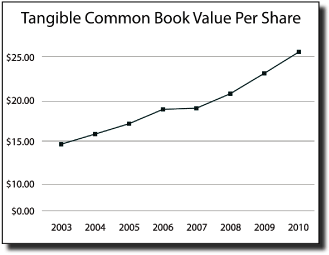
Another Look at FDIC-Assisted Transactions
Since late 2007, the FDIC has closed more than 300 banks across the country. As the FDIC seizes and closes these banks, they look for partners to take over responsibility for the assets and deposits of the failed banks.
As we discussed in last year’s letter, there are benefits to purchasing a failed bank from the FDIC:
| | • | | The acquiring bank usually just assumes the deposits, loans and some other assets and liabilities without paying cash. |
| |
| | • | | The transactions are often immediately accretive to the acquirer’s net income. |
There are also drawbacks:
| | • | | Usually, the acquirer willing to take on the most risk wins. |
| |
| | • | | The acquiring bank has to work hard to attempt to collect on the acquired non-performing loan portfolio requiring substantial resources. |
| |
| | • | | Based on the structure of the individual purchase, additional payments may be required to the FDIC up to 10 years after the transaction. |
In 2010 and early 2011, the Company purchased four banks from the FDIC:
| | • | | Lincoln Park Savings Bank (now Lincoln Park Community Bank). |
| |
| | • | | Wheatland Bank (now Naperville Bank & Trust) |
| |
| | • | | Ravenswood Bank (now Ravenswood Community Bank) |
| |
| | • | | Community First Bank-Chicago (to be renamed Rogers Park Community Bank) |
We bid on several others that we did not win. The bidding has become extremely competitive. As shareholders, you should know that your company examines each opportunity carefully and is only willing to purchase banks (through the FDIC or otherwise) that are advantageous for the Company.
Put simply, we want to make purchases on our terms. Any purchase should:
| | • | | Provide us with locations in markets we currently do not serve or in-market locations that can effectively supplement our existing franchises. |
| |
| | • | | Come with strong customer household and deposit franchises or provide the financial benefits which more than compensate for the lack of a true retail banking franchise. |
| |
| | • | | Be immediately accretive to Wintrust s earnings. |
When we do have the opportunity to take over a failed bank, we follow a detailed plan that helps ensure that we get the most out of our purchase.
2011 will bring even more opportunities for FDIC-assisted and non-assisted transactions. Know that we continue to examine each carefully-putting the continued growth and financial security of your company first.
A Final Note on TARP & CPP
The U.S. Treasury’s Troubled Asset Relief Program (TARP) has been a controversial program since its inception in the fall of 2008. Regardless of your views of TARP and its Capital Purchase Program (CPP), we want you, as our shareholders, friends, neighbors and customers, to understand our past participation in it.
The Treasury started CPP to help stabilize and add capital into the financial system, by making investments in healthy banks. After all, it is capital that makes it possible for banks to make loans, issue lines of credit, and, when necessary, write off bad loans.
Wintrust received an investment of $250 million from CPP on December 19,2008.
Here’s what we did with it -
| | • | | Made more than $19 billion in new and renewed loans in 2009 and 2010. Banks are in the business to lend money and we never stopped lending. |
| |
| | • | | Added more than 200 new employees. |
| |
| | • | | Purchased three banks from the FDIC, allowing true community and neighborhood banks to remain and grow in Naperville, Illinois and Chicago’s north side. |
| |
| | • | | Paid $25 million in dividends (a 5% annual return) to the U.S. Treasury and the American Taxpayers. |
Two years and three days after we accepted the investment, we paid it all back. Additionally, in February 2011, the U.S. Treasury sold the warrants to purchase our common stock that it held, netting the U.S. Treasury an additional $25.6 million. The U.S. Treasury made a more than 20% return on the two year investment it made in Wintrust.
As of the writing of this letter, according to the U.S. Treasury, $243 billion of the originally dispersed $245 billion TARP funds has been repaid. As of February 2011, the U.S. Treasury estimates that the TARP bank programs will result in a profit of nearly $20 billion for American taxpayers.
Not bad for a heavily maligned program that is credited with helping to “break the back of the financial crisis, avert a second Great Depression, and restart economic growth.”
—Acting Assistant Secretary for Financial Stability,
U.S. Treasury February 2, 2011.
Our capital raises in 2010 netted Wintrust more than $537 million in new capital. The first common stock offering in March brought $210.3 million, with December’s offerings of common stock and tangible equity units netting $327.5 million.
We used about half of the net proceeds of the capital offerings to redeem the preferred shares we originally issued to the U.S. Treasury, exiting from the TARP Capital Purchase Program. (Please see the sidebar: “A Final Note on TARP & CPP”) The remaining capital will allow us to make more loans, purchase additional banks and grow the business.
Since we continued to be profitable, we paid dividends to our shareholders of nine cents per common share in each of February and August. We believe it is important to pay a dividend but also to retain the vast majority of net earnings to support additional growth and work to increase shareholder value over time.
Scene 7 — 2011: The Fight Continues.
We expect 2011 to bring continued growth and improvements in our core earnings. We’ll do this with the understanding that we will always protect our shareholders and take care of our customers, after all we would not be successful without both. We also understand that we have to continue to get the word out, spreading the Wintrust story across our market area.
Get the Word Out
In 2007, we started promoting Wintrust as a business and commercial banking brand. Realizing that middle-market businesses would question if a community bank could meet their complex needs, we spoke to Wintrust’s size, financial strength and robust treasury management solutions.
We also started migrating some of our larger retail brands to Wintrust. MaxSafe is marketed as being offered by Wintrust Community Banks. Our mortgage company became Wintrust Mortgage Corporation in late 2008. In 2010, our wealth management companies became collectively marketed as Wintrust Wealth Management, comprised of Wayne Hummer Investments, The Chicago Trust Company and Wintrust Capital Management.
| | |
| | | |
| |
| | | |
| 12 | | Wintrust Financial Corporation |
Last year, our commercial banking efforts rebranded as Wintrust Commercial Banking. Available through every Wintrust bank, Wintrust Commercial Banking is quickly becoming the solution for middle-market businesses throughout the Chicago area and Southeastern Wisconsin.
The Wintrust name will become more prominent in 2011. To coincide with our roll-out of full affiliate banking later in the year, we will start sub-branding our banks as Wintrust Community Banks. This allows us to leverage the Wintrust name across the entire organization, while never sacrificing the local brands and community bank positioning we’ve spent the last two decades building.
With continued aggressive sales and marketing efforts across the banks, commercial lending teams and niches, we expect to continue to build our brands, market share and business.
To Be Continued . . .
We believe this movie is reaching a turning point. There are more storyboards to create to achieve our goal of beingthecommunity banks of choice to serve the Chicago area and Southeastern Wisconsin.
Taking Care of Our Customers
From the beginning, we’ve always had a simple philosophy:
| | • | | Offer the same or better products as the big banks. |
| |
| | • | | Provide the same or better technology and access. |
| |
| | • | | Provide unmatched personal service. |
For us, this has always meant doing more than just “being a bank,” focusing less on what is seen as traditional banking and more on customer engagement and loyalty.
Our Junior Savers and Platinum Adventures Clubs continue to be shining examples of this. Designed to teach children the importance of saving, Junior Saver Club families at all of our banks were invited to games, cookouts, Santa (with reindeer) and other family events throughout the course of the year.
Both clubs should see further expansion in 2011, as we introduce them to new markets, enhance the products and activities available to current members and expand the customers we target with both programs.
We further expanded our relationships with our customers by hosting a number of seminars by our bankers, financial advisors and loan officers to assist families in our communities get a handle on their financial lives. From seminars on Basic Investing to Saving for College to Teaching Your Teens About Money, our customers and neighbors flocked to our banks.
We also expanded a number of initiatives to help those customers and neighbors who may need a little more help with their finances. Our banks introduced the FDIC’s Money Smart program to their markets in 2010. This series of financial literacy classes has already drawn a sizable following and will be expanded across the network in 2011. This combined with one-time classes (ranging from “Understanding Your Credit Score” to “How to Buy Your First Home”) and specialized product offerings specifically for low and moderate income households has dramatically increased our ability to reach out to these segments.
Taking care of our customers includes improving access to their finances, the bank and to information. We added personal financial management software to our on-line banking system in 2010, giving customers the ability to budget, aggregate all their financial behavior in one place and manage their finances. We also added Mobile Alerts for our customers. In 2011, we plan to enhance our customers’ mobile access with the addition of full mobile banking and giving retail customers the ability to take a picture or scan a check and electronically deposit it.
We are also upgrading and expanding our ATM network and enhancing our systems to allow all our customers to bank at all of our locations. Being able to bank across our network of affiliated banks will allow our customers to take full advantage of the entire network, while knowing the community bank experience they expect will follow them throughout the area.
In previous shareholder letters, we’ve discussed our belief that the banking business and our mission had come full circle. We started at a time when the big banks were consolidating and seeing just how far they could push their customers. We are now in a time where the big banks are once again pushing their customers around and away with increased fees and reduced service.
We have a genuine opportunity to further differentiate ourselves. 2011 should be an opportunistic year for us.
Thank you for being a shareholder. We hope to see you at our Annual Meeting on May 26, 2011 at 10:00 a.m. at the Deer Path Inn, located in downtown Lake Forest.
| | | | | |
Sincerely,  Peter D. Crist Chairman | |

Edward J. Wehmer
President &
Chief Executive Officer | |

David A. Dykstra
Senior Executive Vice President &
Chief Operating Officer |
| | |
| | | |
| |
| | | |
| 14 | | Wintrust Financial Corporation |
Our Banking, Mortgage, and Wealth Management Locations
THIS PAGE INTENTIONALLY LEFT BLANK
| | |
| | | |
| 16 | | Wintrust Financial Corporation |
Banking & Wealth Management Locations
| |
|
Corporate Headquarters |
Wintrust Financial Corporation |
| 727 North Bank Lane |
| Lake Forest, IL 60045 |
| 847-615-4096 |
| |
Illinois Banking & Wealth Management |
Locations |
| |
ALGONQUIN |
Algonquin Bank & Trust |
Wintrust Wealth Management |
| 4049 W. Algonquin Rd. |
| Algonquin, IL 60102 |
| 847-669-7500 |
| |
ANTIOCH |
State Bank of The Lakes |
Wintrust Wealth Management |
| 440 Lake St. |
| Antioch, IL 60002 |
| 847-395-2700 |
| |
ARLINGTON HEIGHTS |
Village Bank & Trust |
| 234 W. Northwest Hwy. |
| Arlington Heights, IL 60004 |
| 847-670-1000 |
Village Bank & Trust |
| 150 E. Rand Rd. |
| Arlington Heights, IL 60004 |
| 847-870-5000 |
Village Bank & Trust |
Wintrust Wealth Management |
| 311 S. Arlington Heights Rd. |
| Arlington Heights, IL 60005 |
| 847-483-6000 |
| |
BARRINGTON |
Barrington Bank & Trust Company |
Wintrust Wealth Management |
| 201 S. Hough St. |
| Barrington, IL 60010 |
| 847-842-4500 |
Barrington Bank & Trust Company |
| 233 W. Northwest Hwy. |
| Barrington, IL 60010 |
| 847-381-1715 |
Barrington Bank & Trust Company |
| 217 S. Hough St. |
| Barrington, IL 60010 |
| 847-842-4500 |
| |
|
BLOOMINGDALE |
Old Town Bank & Trust of Bloomingdale |
Wintrust Wealth Management |
| 165 W. Lake St. |
| Bloomingdale, IL 60108 |
| 630-295-9111 |
| |
BUFFALO GROVE |
Buffalo Grove Bank & Trust |
| 200 N. Buffalo Grove Rd. |
| Buffalo Grove, IL 60089 |
| 847-634-8400 |
| |
CARY |
Cary Bank & Trust |
| 60 E. Main St. |
| Cary, IL 60013 |
| 847-462-8881 |
| |
CHICAGO |
Wintrust Commercial Banking — |
Chicago Loan Office |
| 190 South LaSalle Street |
| 22th Floor |
| Chicago, IL 60603 |
| 312-291-2900 |
Wintrust Wealth Management — |
HEADQUARTERS |
| 222 South Riverside Plaza |
| 28th Floor |
| Chicago, IL 60606 |
| 312-431-1700 |
Beverly Bank & Trust Company |
Wintrust Wealth Management |
| 10258 S. Western Ave. |
| Chicago, IL 60643 |
| 773-239-2265 |
Beverly Bank & Trust Company |
| 1908 W. 103rd St. |
| Chicago, IL 60643 |
| 773-239-2265 |
Lincoln Park Community Bank |
Wintrust Wealth Management |
| 1946 W. Irving Park Rd. |
| Chicago, IL 60613 |
| 773-525-2023 |
Lincoln Park Community Bank |
| 2139 W. Irving Park Rd. |
| Chicago, IL 60618 |
| 773-267-3990 |
Lincoln Park Community Bank |
| 3234 N. Damen Ave. |
| Chicago, IL 60618 |
| 773-871-1986 |
Lincoln Park Community Bank |
| 3050 N. Harlem Ave. |
| Chicago, IL 60634 |
| 773-622-5301 |
| |
|
Lincoln Park Community Bank |
| 2107 W. Irving Park Rd. |
| Chicago, IL 60618 |
| 773-539-1704 |
North Shore Community Bank & Trust Co. |
Wintrust Wealth Management |
| 4343 W. Peterson Ave. |
| Chicago, IL 60646 |
| 773-545-5700 |
Ravenswood Bank |
| 2300 W. Lawrence Ave. |
| Chicago, IL 60625 |
| 773-907-8100 |
| |
CLARENDON HILLS |
Clarendon Hills Bank |
| 200 W. Burlington Ave. |
| Clarendon Hills, IL 60514 |
| 630-323-1240 |
| |
CRYSTAL LAKE |
Crystal Lake Bank & Trust Company |
| 70 N. Williams St. |
| Crystal Lake, IL 60014 |
| 815-479-5200 |
Crystal Lake Bank & Trust Company |
| 27 N. Main St. |
| Crystal Lake, IL 60014 |
Crystal Lake Bank & Trust Company |
| 1000 McHenry Ave. |
| Crystal Lake, IL 60014 |
| 815-479-5715 |
| |
DEERFIELD |
Deerfield Bank & Trust |
| 660 Deerfield Rd. |
| Deerfield, IL 60015 |
| 847-945-8660 |
| |
DOWNERS GROVE |
Community Bank of Downers Grove |
Wintrust Wealth Management |
| 1111 Warren Ave. |
| Downers Grove, IL 60515 |
| 630-968-4700 |
Community Bank of Downers Grove |
| 718 Ogden Ave. |
| Downers Grove, IL 60515 |
| 630-435-3600 |
| |
ELK GROVE VILLAGE |
Elk Grove Village Bank & Trust |
| 75 E. Turner Ave. |
| Elk Grove Village, IL 60007 |
| 847-364-0100 |
2010Annual Report
| |
|
FRANKFORT |
Old Plank Trail Community Bank |
| 20901 S. LaGrange Rd. |
| Frankfort, IL 60423 |
| 815-464-6888 |
| |
GENEVA |
St. Charles Bank & Trust Company |
| 2401 Kaneville Rd. |
| Geneva, IL 60134 |
| 630-845-4800 |
| |
GLEN ELLYN |
Glen Ellyn Bank & Trust |
Wintrust Wealth Management |
| 500 Roosevelt Rd. |
| Glen Ellyn, IL 60137 |
| 630-469-3000 |
| |
GLENCOE |
North Shore Community Bank & Trust Co. |
| 362 Park Ave. |
| Glencoe, IL 60022 |
| 847-835-1700 |
North Shore Community Bank & Trust Co. |
| 633 Vernon Ave. |
| Glencoe, IL 60022 |
| |
GRAYSLAKE |
State Bank of The Lakes |
Wintrust Wealth Management |
| 50 Commerce Dr. |
| Grayslake, IL 60030 |
| 847-548-2700 |
| |
GURNEE |
Gurnee Community Bank |
Wintrust Wealth Management |
| 675 N. O’Plaine Rd. |
| Gurnee, IL 60031 |
| 847-625-3800 |
| |
HIGHLAND PARK |
Highland Park Bank & Trust |
| 1949 St. Johns Ave. |
| Highland Park, IL 60035 |
| 847-432-9988 |
Highland Park Bank & Trust |
| 643 Roger Williams Ave. |
| Highland Park, IL 60035 |
| 847-266-0300 |
| |
HIGHWOOD |
Bank of Highwood — Fort Sheridan |
| 507 Sheridan Rd. |
| Highwood, IL 60040 |
| 847-266-7600 |
| |
|
HINSDALE |
Hinsdale Bank & Trust Company |
Wintrust Wealth Management |
| 25 E. First St. |
| Hinsdale, IL 60521 |
| 630-323-4404 |
Hinsdale Bank & Trust Company |
| 130 W. Chestnut St. |
| Hinsdale, IL 60521 |
| 630-655-8025 |
| |
HOFFMAN ESTATES |
Hoffman Estates Community Bank |
| 1375 Palatine Rd. |
| Hoffman Estates, IL 60192 |
| 847-963-9500 |
Hoffman Estates Community Bank |
| 2497 W. Golf Rd. |
| Hoffman Estates, IL 60169 |
| 847-884-0500 |
| |
ISLAND LAKE |
Wauconda Community Bank |
| 229 E. State Rd. |
| Island Lake, IL 60042 |
| 847-487-3777 |
| |
LAKE BLUFF |
Lake Forest Bank & Trust Company |
| 103 E. Scranton Ave. |
| Lake Bluff, IL 60044 |
| 847-615-4060 |
| |
LAKE FOREST |
Lake Forest Bank & Trust Company |
Wintrust Wealth Management |
| 727 N. Bank Ln. |
| Lake Forest, IL 60045 |
| 847-234-2882 |
Lake Forest Bank & Trust Company |
| 780 N. Bank Ln. |
| Lake Forest, IL 60045 |
| 847-615-4022 |
Lake Forest Bank & Trust Company |
| 911 S. Telegraph Rd. |
| Lake Forest, IL 60045 |
| 847-615-4098 |
Lake Forest Bank & Trust Company |
Wintrust Wealth Management |
| 810 S. Waukegan Rd. |
| Lake Forest, IL 60045 |
| 847-615-4080 |
| |
LAKE VILLA |
State Bank of The Lakes |
| 345 S. Milwaukee Ave. |
| Lake Villa, IL 60046 |
| 847-265-0300 |
| |
|
LIBERTYVILLE |
Libertyville Bank & Trust Company |
| 507 N. Milwaukee Ave. |
| Libertyville, IL 60048 |
| 847-367-6800 |
Libertyville Bank & Trust Company |
| 201 E. Hurlburt Ct. |
| Libertyville, IL 60048 |
| 847-247-4045 |
Libertyville Bank & Trust Company |
Wintrust Wealth Management |
| 1200 S. Milwaukee Ave. |
| Libertyville, IL 60048 |
| 847-367-6800 |
| |
LINDENHURST |
State Bank of The Lakes |
| 2031 Grand Ave. |
| Lindenhurst, IL 60046 |
| 847-356-5700 |
| |
McHENRY |
McHenry Bank & Trust |
| 2205 N. Richmond Rd. |
| McHenry, IL 60050 |
| 815-344-6600 |
McHenry Bank & Trust |
| 2730 W. Route 120 |
| McHenry, IL 60051 |
| 815-344-5100 |
| |
MOKENA |
Old Plank Trail Community Bank |
Wintrust Wealth Management |
| 20012 Wolf Rd. |
| Mokena, IL 60448 |
| 708-478-4447 |
| |
MOUNT PROSPECT |
Ravenswood Bank |
| 320 E. Northwest Highway |
| Mundelein, IL 60056 |
| 847-398-6100 |
| |
MUNDELEIN |
Mundelein Community Bank |
| 1110 W. Maple Ave. |
| Mundelein, IL 60060 |
| 847-837-1110 |
| |
NAPERVILLE |
Naperville Bank & Trust |
| 555 Fort Hill Dr. |
| Naperville, IL 60540 |
| 630-369-3555 |
Wintrust Financial Corporation
| |
|
NEW LENOX |
Old Plank Trail Community Bank |
Wintrust Wealth Management |
| 280 Veterans Pkwy. |
| New Lenox, IL 60451 |
| 815-485-0001 |
| |
NORTH CHICAGO |
North Chicago Community Bank |
| 1801 Sheridan Rd. |
| North Chicago, IL 60064 |
| 847-473-3006 |
| |
NORTHBROOK |
Northbrook Bank & Trust Company |
| 1100 Waukegan Rd. |
| Northbrook, IL 60062 |
| 847-418-2800 |
Northbrook Bank & Trust Company |
| 875 Sanders Rd. |
| Northbrook, IL 60062 |
| 847-418-2850 |
| |
NORTHFIELD |
Northview Bank & Trust |
Wintrust Wealth Management |
| 245 Waukegan Rd. |
| Northfield, IL 60093 |
| 847-446-0245 |
Northview Bank & Trust |
| 1751 Orchard Ln. |
| Northfield, IL 60093 |
| 847-441-1751 |
| |
PALATINE |
Palatine Bank & Trust |
Wintrust Wealth Management |
| 110 W. Palatine Rd. |
| Palatine, IL 60067 |
| 847-963-0047 |
| |
PROSPECT HEIGHTS |
Village Bank & Trust |
| 1845 E. Rand Rd. |
| Prospect Heights, IL 60004 |
| 847-483-6000 |
| |
RIVERSIDE |
Riverside Bank |
| 17 E. Burlington |
| Riverside, IL 60546 |
| 708-447-3222 |
| |
ROSELLE |
Roselle Bank & Trust |
| 1350 W. Lake St. |
| Roselle, IL 60172 |
| 630-529-0100 |
| |
|
SKOKIE |
North Shore Community Bank & Trust Co. |
| 7800 Lincoln Ave. |
| Skokie, IL 60077 |
| 847-933-1900 |
| |
SPRING GROVE |
State Bank of The Lakes |
| 1906 Holian Dr. |
| Spring Grove, IL 60081 |
| 815-675-3700 |
| |
ST. CHARLES |
St. Charles Bank & Trust Company |
| 411 West Main St. |
| St. Charles, IL 60174 |
| 630-377-9500 |
| |
VERNON HILLS |
Vernon Hills Bank & Trust |
Wintrust Wealth Management |
| 1101 Lakeview Parkway |
| Vernon Hills, IL 60061 |
| 847-247-1300 |
| |
WAUCONDA |
Wauconda Community Bank |
| 495 W. Liberty St. |
| Wauconda, IL 60084 |
| 847-487-2500 |
| |
WESTERN SPRINGS |
The Community Bank of Western Springs |
Wintrust Wealth Management |
| 1000 Hillgrove Ave. |
| Western Springs, IL 60558 |
| 708-246-7100 |
| |
WHEATON |
Wheaton Bank & Trust Company |
| 211 S. Wheaton Ave. |
| Wheaton, IL 60187 |
| 630-690-1800 |
| |
WILLOWBROOK |
Community Bank of Willowbrook |
| 6262 S. Route 83 |
| Willowbrook, IL 60527 |
| 630-920-2700 |
| |
WILMETTE |
North Shore Community Bank & Trust Co. |
Wintrust Wealth Management |
| 1145 Wilmette Ave. |
| Wilmette, IL 60091 |
| 847-853-1145 |
North Shore Community Bank & Trust Co. |
Wintrust Wealth Management |
| 720 12th St. |
| Wilmette, IL 60091 |
| |
|
North Shore Community Bank & Trust Co. |
| 351 Linden Ave. |
| Wilmette, IL 60091 |
| |
WINNETKA |
North Shore Community Bank & Trust Co. |
| 576 Lincoln Ave. |
| Winnetka, IL 60093 |
| 847-441-2265 |
| |
Wisconsin Banking & Wealth
Management Locations |
| |
APPLETON |
Wintrust Wealth Management |
| 200 East Washington Street |
| Appleton, WI 54911 |
| 920-734-1474 |
| |
DELAFIELD |
Town Bank of Delafield |
| 400 Genesee St. |
| Delafield, WI 53018 |
| 262-646-6888 |
| |
ELM GROVE |
Town Bank of Elm Grove |
| 13150 Watertown Plank Rd. |
| Elm Grove, WI 53122 |
| 262-789-8696 |
| |
HARTLAND |
Town Bank of Hartland |
Wintrust Wealth Management |
| 850 W. North Shore Dr. |
| Hartland, WI 53029 |
| 262-367-1900 |
| |
MADISON |
Town Bank of Madison |
| 10 W. Mifflin St. |
| Madison, WI 53703 |
| 608-282-4840 |
| |
MILWAUKEE |
Town Bank Loan Processing Office |
| 111 E. Kilbourn Ave. |
| Milwaukee, WI 53202 |
| 414-273-1799 |
| |
WALES |
Town Bank of Wales |
| 511 N. Wales Rd. |
| Wales, WI 53183 |
| 262-968-1740 |
2010Annual Report
Other Locations
| |
|
FIRST Insurance |
Funding Corp. |
| 450 Skokie Blvd., Suite 1000 |
| Northbrook, IL 60062 |
| 847-374-3000 |
| |
FIRST Life Funding |
| 101 Hudson Street, 35th Floor |
| Jersey City, NJ 07302 |
| 201-332-7349 |
| |
Broadway Premium Funding Corporation |
| 1747 Veterans Memorial Highway |
| Suite 22 |
| Islandia, NY 11749 |
| 212-791-7099 |
| |
Tricom, Inc. of Milwaukee |
| N48 W16866 Lisbon Road |
| Menomonee Falls, WI 53051 |
| 262-509-6200 |
Wintrust Mortgage Corporation
| |
|
Headquarters |
| 1 South 660 Midwest Rd., Suite 100 |
| Oakbrook Terrace, Illinois 60181 |
| 630-916-9299 |
Branch Offices
| | | | | |
| Phoenix, AZ | | Highland Park, IL | | Schaumburg, IL |
| Denver, CO | | Highwood, IL | | St. Charles, IL |
| Madison, GA | | Hinsdale, IL | | Tinley Park, IL |
| Algonquin, IL | | Hoffman Estates, IL | | Vernon Hills, IL |
| Arlington Heights, IL | | Island Lake, IL | | Wauconda, IL |
| Barrington, IL | | Lake Bluff, IL | | Western Springs, IL |
| Bloomington, IL | | Lake Forest, IL | | Wheaton, IL |
| Buffalo Grove, IL | | Libertyville, IL | | Willowbrook, IL |
| Cary, IL | | McHenry, IL | | Crown Point, IN |
| Champaign, IL | | Mokena, IL | | Greenwood, IN |
| Chicago, IL | | Mundelein, IL | | Indianapolis, IN |
| Clarendon Hills, IL | | Naperville, IL | | Overland Park, KS |
| Crystal Lake, IL | | New Lenox, IL | | Louisville, KY |
| Deerfield, IL | | North Chicago, IL | | Hanover, MD |
| Downers Grove, IL | | Northbrook, IL | | Pataskala, OH |
| Elk Grove Village, IL | | Northfield, IL | | Delafield, WI |
| Elmhurst, IL | | Oakbrook Terrace, IL | | Elm Grove, WI |
| Frankfort, IL | | Palatine, IL | | Hartland, WI |
| Geneva, IL | | Prospect Heights, IL | | Madison, WI |
| Glen Ellyn, IL | | Riverside, IL | | Wales, WI |
| Gurnee, IL | | Roselle, IL | | |
Corporate Information
| |
|
Directors |
| |
| Peter D. Crist (Chairman) |
| Bruce K. Crowther |
| Joseph F. Damico |
| Bert A. Getz, Jr. |
| H. Patrick Hackett, Jr. |
| Scott K. Heitmann |
| Charles H. James, III |
| Albin F. Moschner |
| Thomas J. Neis |
| Christopher J. Perry |
| Hollis W. Rademacher |
| Ingrid S. Stafford |
| Edward J. Wehmer |
| |
Public Listing and Market Symbol |
The Company’s Common Stock is traded on The NASDAQ Global Select Market® under the symbol WTFC. The Company’s warrants to purchase common stock are traded on The NASDAQ Global Select Market® under the symbol WTFCW.
Annual Meeting of Shareholders
May 26, 2011
10:00 a.m.
Deer Path Inn
255 E. Illinois Road
Lake Forest, Illinois 60045
Website Location
The Company maintains a financial relations internet website at the following location: www.wintrust.com
Form 10-K
The Annual Report on Form 10-K to the Securities and Exchange Commission is available on the Internet at the Securities and Exchange Commission’s website. The address for the web site is: http: //www.sec.gov.
Transfer Agent
IST Shareholder Services
209 West Jackson Boulevard
Suite 903
Chicago, Illinois 60606
Telephone: 800-757-5755
Facsimile: 312-427-2879
Wintrust Financial Corporation

